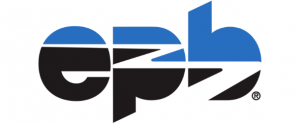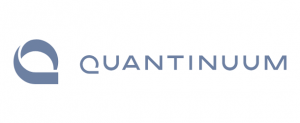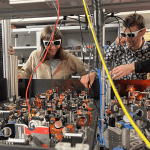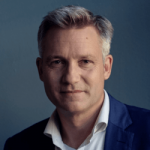Quantum News Briefs March 24: Chattanooga launches “Gig City Goes Quantum” to prepare for the Quantum Age, Fujitsu and Osaka University develop new quantum computing architecture; KPMG & Microsoft join Quantinuum in simplifying quantum algorithm development via the cloud + MORE.

Quantum News Briefs March 24: Chattanooga launches “Gig City Goes Quantum” to prepare for the Quantum Age; Fujitsu and Osaka University develop new quantum computing architecture; KPMG & Microsoft join Quantinuum in simplifying quantum algorithm development via the cloud + MORE.
Chattanooga launches “Gig City Goes Quantum” to prepare for the Quantum Age
 Chattanooga Mayor Tim Kelly announced “Gig City Goes Quantum,” a new initiative to prepare for education, jobs and business opportunities in the emerging quantum technology sector at a recent meeting of the Quantum Economic Development Consortium (QED-C). Quantum News Briefs summarizes the recent announcement.
Chattanooga Mayor Tim Kelly announced “Gig City Goes Quantum,” a new initiative to prepare for education, jobs and business opportunities in the emerging quantum technology sector at a recent meeting of the Quantum Economic Development Consortium (QED-C). Quantum News Briefs summarizes the recent announcement.
Gig City Goes Quantum will leverage EPB Quantum NetworkSM powered by Qubitekk to accelerate the commercialization of quantum technologies through collaboration with community leaders, universities, schools and companies starting in Chattanooga and spreading cooperatively across the U.S. Gig City Goes Quantum’s first effort begins on World Quantum Day, April 14, with the goal of engaging people of all ages in 1,000+ Quantum Learning Activities by May 31.
“The launch of EPB’s Quantum Network has positioned Chattanooga to lead in quantum information technology, but there’s still a lot we need to do to prepare our city to thrive in a new quantum age,” said Chattanooga Mayor Tim Kelly. “Gig City Goes Quantum is a collaborative effort to build a new quantum ecology starting right here in Chattanooga, with student education, workforce preparation, and support of companies that are leading the way in translating quantum possibilities into real-world solutions.”
“This partnership between EPB and Hamilton County Schools presents a unique opportunity for us to be a leader in quantum education and create a talent pipeline that is essential for advancing an innovative local economy,” stated Hamilton County Mayor Weston Wamp. “We believe in equipping our students with new skillsets and knowledge that they can apply towards their future career paths, whether it’s in higher education or vocational training.”
Gig City Goes Quantum collaborators include educators, scientists, entrepreneurs and community leaders focused on preparing Chattanooga for the emerging quantum sector which holds the promise to revolutionize computing, cybersecurity, healthcare, finance and many other in-demand fields.
Although resources at GigCityGoesQuantum.com are available to anyone, educators in particular are invited to register for a free Quantum Education Kit with links to videos and educational resources for use in classrooms. Livestream activities are open to watch online for everyone with interest, and videos will be archived at GigCityGoesQuantum.com along with access to other free activities developed by national and local educators, physicists, workforce development professionals and entrepreneurs. Click here to read complete announcement in the EPB newsroom.
Fujitsu and Osaka University develop new quantum computing architecture
 Fujitsu and Osaka University’s Center for Quantum Information and Quantum Biology have revealed the development of a new, highly efficient analog rotation quantum computing architecture, representing a significant milestone toward the realization of practical quantum computing.
Fujitsu and Osaka University’s Center for Quantum Information and Quantum Biology have revealed the development of a new, highly efficient analog rotation quantum computing architecture, representing a significant milestone toward the realization of practical quantum computing.
The new architecture reduces the number of physical qubits required for quantum error correction – a prerequisite for the realization of fault-tolerant quantum computing – by 90% from 1 million to 10,000 qubits. This breakthrough will allow research to embark on the construction of a quantum computer with 10,000 physical qubits and 64 logical qubits, which corresponds to computing performance of approximately 100,000 times that of the peak performance of conventional high performance computers.
Moving forward, Fujitsu and Osaka University will further refine this new architecture to lead the development of quantum computers in the early FTQC era, with the aim of applying quantum computing applications to a wide range of practical societal issues including material development and finance.
By redefining the universal quantum gate set, Fujitsu and Osaka University succeeded in implementing a phase rotating gate – a world first– which enables highly efficient phase rotation, a process which previously required a high number of physical qubits and quantum gate operations.
In this way, the two parties succeeded in reducing the number of qubits required for quantum error correction to around 10% of existing technologies, and the number of gate operations required for arbitrary rotation to approx. 5% of conventional architectures. In addition, Fujitsu and Osaka University suppressed quantum error probability in physical qubits to about 13%, thus achieving highly accurate calculations. Click here to read the original article in-entirety.
KPMG & Microsoft join Quantinuum in simplifying quantum algorithm development via the cloud
 There are efforts around the world to make it simpler for engineers and developers across many sectors to take advantage of quantum computers by translating between high level coding languages and tools, and quantum circuits — the combinations of gates that run on quantum computers to generate solutions. Many of these efforts focus on hybrid quantum-classical workflows, which allow a problem to be solved by taking advantage of the strengths of different modes of computation, accessing central processing units (CPUs), graphical processing units (GPUs) and quantum processing units (QPUs) as needed.
There are efforts around the world to make it simpler for engineers and developers across many sectors to take advantage of quantum computers by translating between high level coding languages and tools, and quantum circuits — the combinations of gates that run on quantum computers to generate solutions. Many of these efforts focus on hybrid quantum-classical workflows, which allow a problem to be solved by taking advantage of the strengths of different modes of computation, accessing central processing units (CPUs), graphical processing units (GPUs) and quantum processing units (QPUs) as needed.
Microsoft is a significant contributor to this burgeoning quantum ecosystem, providing access to multiple quantum computing systems through Azure Quantum, and a founding member of the QIR Alliance, a cross-industry effort to make quantum computing source code portable across different hardware systems and modalities and to make quantum computing more useful to engineers and developers. QIR offers an interoperable specification for quantum programs, including a hardware profile designed for Quantinuum’s H-Series quantum computers, and has the capacity to support cross-compiling quantum and classical workflows, encouraging hybrid use-cases.
As one of the largest integrated quantum computing companies in the world, Quantinuum was excited to become a QIR steering member alongside partners including Nvidia, Oak Ridge National Laboratory, Quantum Circuits Inc., and Rigetti Computing. Quantinuum supports multiple open-source eco-system tools including its own family of open-source software development kits and compilers, such as TKET for general purpose quantum computation and lambeq for quantum natural language processing.
As founding members of QIR, Quantinuum recently worked with Microsoft Azure Quantum alongside KPMG on a project that involved Microsoft’s Q#, a stand-alone language offering a high level of abstraction and Quantinuum’s System Model H1, Powered by Honeywell. The Q# language has been designed for the specific needs of quantum computing and provides a high-level of abstraction enabling developers to seamlessly blend classical and quantum operations, significantly simplifying the design of hybrid algorithms.
KPMG’s quantum team wanted to translate an existing algorithm into Q#, and to take advantage of the unique and differentiating capabilities of Quantinuum’s H-series, particularly qubit reuse, mid-circuit measurement and all-to-all connectivity. System Model H1 is the first generation trapped-ion based quantum computer built using the quantum charge-coupled device (QCCD) architecture. KPMG accessed the H1-1 QPU with 20 fully connected qubits. H1-1 recently achieved a Quantum Volume of 32,768, demonstrating a new high-water mark for the industry in terms of computation power as measured by quantum volume. Click here to read indepth, complete report on Quantinuum website.
BosonQ Psi joins IBM Quantum Network to enhance research and proof of concept projects with quantum-powered simulations
 BosonQ Psi (BQP) has joined the IBM Quantum Network startup program and intends to experiment and develop quantum algorithms for engineering simulations on quantum systems. Collaborating with established researchers from universities, R&D labs, and end-user industries, BosonQ Psi intends to boost the performance of complex engineering simulations using Qiskit libraries, simulators, and IBM quantum systems via the cloud.
BosonQ Psi (BQP) has joined the IBM Quantum Network startup program and intends to experiment and develop quantum algorithms for engineering simulations on quantum systems. Collaborating with established researchers from universities, R&D labs, and end-user industries, BosonQ Psi intends to boost the performance of complex engineering simulations using Qiskit libraries, simulators, and IBM quantum systems via the cloud.
BQP’s quantum-powered simulation platform serves applications in aerospace, automotive, manufacturing, biotech, and many other industries. BQP’s state-of-the-art capabilities allow researchers to engage in proof-of-concept projects and simulations. Quantum-powered simulations aim to provide innovative breakthrough solutions for complex engineering problems with realistic, accurate, and accelerated simulations.
Rut Lineswala, Founder and CTO, BQP said “We are very excited to be part of the IBM Quantum Network. We are getting overwhelming traction for our simulation platform, and this announcement couldn’t have come at a better time. Being part of IBM’s network allows our team to experiment and harness the scalability of our hybrid quantum-classical algorithms and carry out proof-of-concept projects.”
“India’s quantum ecosystem growth is vitally important to the quantum industry. We believe that BQP’s membership in the IBM Quantum Network will broaden the opportunity for this community of domain experts to learn and explore how quantum computing can help their organizations,” said Aparna Prabhakar, Vice President, IBM Quantum Ecosystem.
Sandra K. Helsel, Ph.D. has been researching and reporting on frontier technologies since 1990. She has her Ph.D. from the University of Arizona.



















